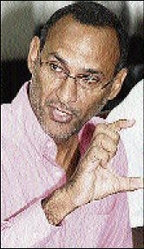

From left, King and Shirley
Gareth Manning, Gleaner Writer
LOCAL FINANCIAL experts have agreed that there is an urgent need for the Government to come clean about the country's indebtedness.
While the official debt figure is $1.2 trillion, the financial experts, who spoke at a recent Gleaner Editors' Forum, agreed the contingent liabilities need to be determined and added to the equation before any credible programme can be implemented to deal with the debt burden.
Contingent liabilities are debts of state entities which are not included in the Budget but which the Government and by extension taxpayers could be asked to pay in the long run.
"We need to get the contingent liabilities stated. Every single loan to state agencies with the numbers as to what was the original thing and what it is now," argues financial analyst Anne Shirley.
Full picture
According to Shirley, the full picture of the liabilities has to be put together so that the Government will know how to treat its total debt.
She says there are about 10 entities which account for the majority of the off-Budget debt facing the Government.
These include the Urban Development Corporation (UDC), the National Water Commission (NWC) and the National Road Operating and Constructing Company (NROCC).
"UDC, starting not just with Sandals Whitehouse, there have been a number of other things including Lift Up Jamaica," Shirley says.
The UDC, as project managers for the construction of the Gordon 'Butch' Stewart Sandals-branded hotel in Whitehouse, Westmoreland, oversaw a $2 billion cost overrun on the project.
Supporting Shirley, economist Dr Damian King argues that the Government does not know its contingent liabilities because of how it manages the affairs of the country.
"The Government does not realise that the IT (information technology) park it announced to be built in St Catherine is a contingent liability. That is a projection for future loss that must come on to the Budget if it doesn't work out," he argues.
Investment and Commerce Minister Karl Samuda has announced the Government's intention to construct an information technology park on 1,000 acres of land at Caymanas, St Catherine.
The park, which is to cost US$3 billion (about $265 billion), is set to be the home of several businesses and the hub of economic activity in the expanded Kingston Metropolitan Region.
But King warns that if the park fails, tax-payers would be forced to bear the cost of its operations.
Already there are some obvious liabilities that will impact on the Budget. These include the debt of loss making entities like Air Jamaica and the Sugar Company of Jamaica (SCJ).
"Air Jamaica's debt is now over US$1 billion and that is a debt - whoever purchases the airline - will not absorb," says Shirley.
"That [debt] is ours to hug up," she says.
The same carries for the SCJ, which is carrying a $21 billion debt burden.
Start at the beginning
But there are other contingent liabilities which are not so obvious and would depend on rigid account management to identify them.
"The whole issue of contingent liability management and appreciation needs to start at the very beginning," King says.
According to him, the present Budget does not focus on fundamental fiscal management reform and discipline which will be a key factor in reducing non-central government liabilities which have been severely impacting on the Budget.
"One of the discoveries that we (CaPRI) made recently when we did an analysis of the growth of Jamaica's debt, from its low point in 1996 and its high point in 2004, is that all the accumulation of debt was due to non-central government (off-Budget) liabilities," King says.
Jamaica's total public debt and indicator 2008/09